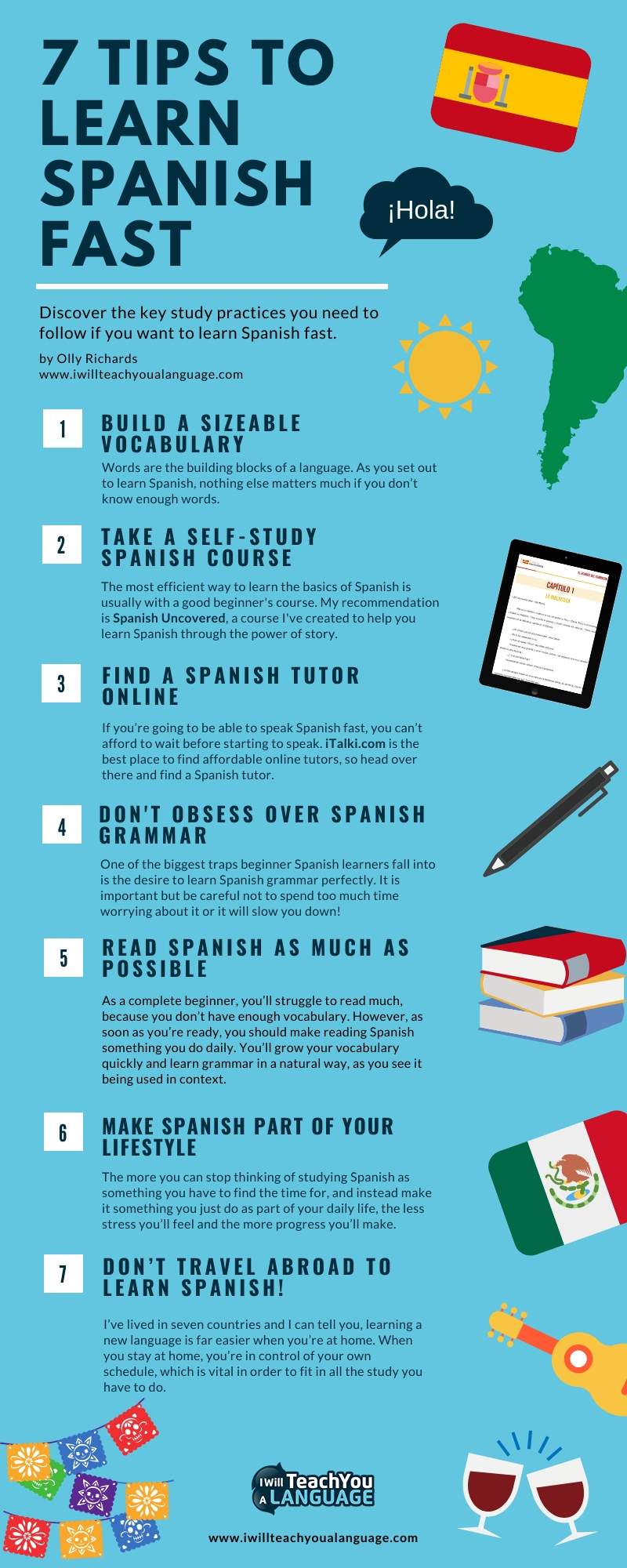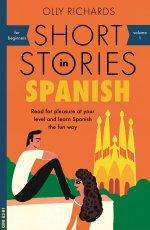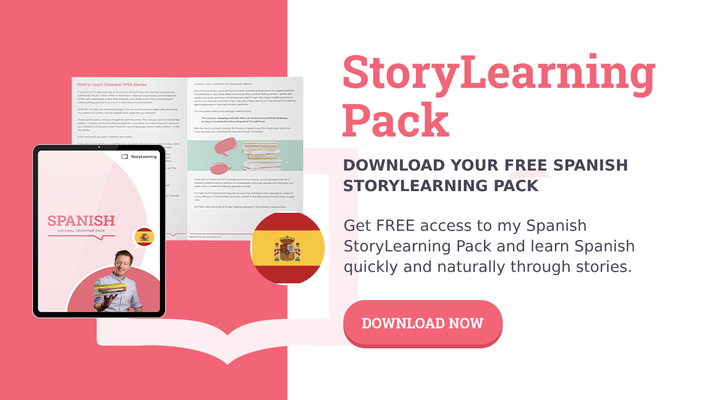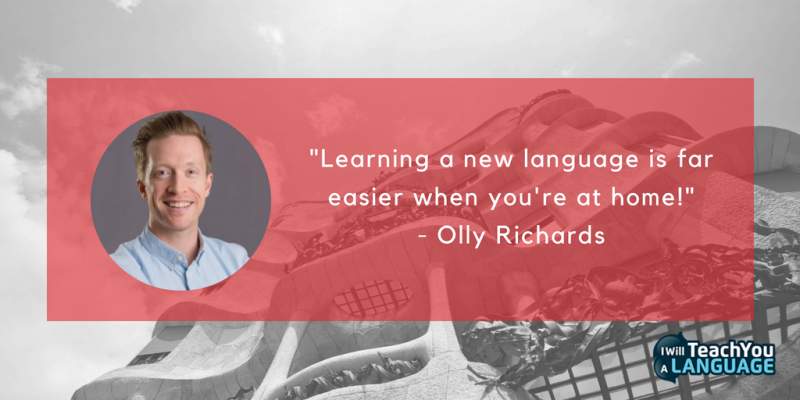How to Learn Spanish Fast and Easy and Free

In this article, I'll show you how to learn Spanish fast!
You'll discover the 7 key areas I'd focus on if I had to learn how to speak Spanish confidently in only a few months.
When I finished school, I only spoke English. But since then I've gone on tolearn 10 languages and what I discovered is that how you learn is the key to success in becoming fluent in a foreign language.
With that in mind, this post breaks down the key study practices you need to follow if you want to get fluent in Spanish fast…
… and at the end, I'll share a sample daily Spanish learning schedule with you, so you know not only what to do, but exactly when to do it!
These are proven strategies that will result in you being able to actually speak Spanish very quickly…
- Without moving abroad
- Without quitting your job to study full-time
- And without marrying a Spanish speaker … at least, not yet!
Be aware, this is intensive!
You'll need to work damn hard, and it might not be for you.
But if you're willing to put in the effort, the results will be more than worth it.
Don't have time to read this now? Click here to download a free PDF of the article.
Learning Spanish – The Big Picture

Before we dive into the tips, let's take a step back and consider what you will have to achieve in order be successful.
Firstly, don't make the mistake of thinking you can't learn Spanish fast!
It is entirely possible, and you'll find plenty of experienced language learners who will testify to this. And you don't necessarily need expensive Spanish classes or fancy learning software to do it.
But you will need guidance (that's what I'm here for!).
In order to learn Spanish fast, in only a few months, you'll need to…
- Build a sizeable vocabulary
- Take a Self-Study Spanish Course
- Find a Spanish Tutor Online
- Don't Obsess Over Spanish Grammar
- Read Spanish as Much as Possible
- Make Spanish Part of Your Lifestyle
- Don't Travel Abroad to Learn Spanish
You can see the entire process in the infographic above.
Now, let's see how to do it…
1. Build A Sizeable Vocabulary In Spanish
Words are the building blocks of a language.
As you set out to learn Spanish, nothing else matters much if you don't know enough words.
Now, the ideal way to grow a sizeable vocabulary in Spanish over time is by learning as you go.
For that reason, some good generic advice is to try to use Spanish in your daily life and concentrate on learning the specific words and phrases that you find most useful.
However, because we're under some time pressure here, you need to take a more direct route.
Here's the key fact…
Studies ofSpanish word frequency tell us that the 1,000 most frequent words in Spanish account for 87.8% of all spoken Spanish.
This means you've only got to learn around 1,000 words to understand the vast majority of everything you will hear in Spanish.
Watch this video to learn my method for memorising any word in Spanish so you never forget it, without learning from vocab lists or flashcards:
Go back to the menu
2. Take A Self-Study Spanish Course
The most efficient way to learn the basics is usually with a good Spanish for beginners course because all the important stuff is laid out for you in an easily-digestible away.
Most importantly of all, make sure the course you choose includes plenty of dialogues and comes with both audio and text so you can improve your listening skills and learn to understand real spoken Spanish.
My recommendation is Spanish Uncovered, which uses a unique story-telling method that's ideal for making Spanish memorable and fun.
Spanish Uncovered takes you all the way from complete beginner to the intermediate level and is based on the same principles you're learning here about how to learn Spanish fast.
Study the video lessons in the course every day, and aim to complete it over the space of 4-6 weeks.
I recommend not spending too much time with the exercises provided. The aim isn't to learn grammar rules to perfection! Instead, aim to complete the entire course so you get a good overview of how the language works, and use the grammar exercises as extra practice to complement your core study time.
Focus most of your energy on reading the story or dialogues, acclimatising to the sounds of Spanish.
But what if you're not a beginner?
If you already speak some Spanish and instead want help to break through the intermediate plateau, invest in a resource that focuses specifically on that intermediate level.
You'll be hard-pressed to find anything better than the Fluent Spanish Academy.
Go back to the menu
3. Find A Spanish Tutor Online

If you're going to be able to speak Spanish fast, you can't afford to wait long before starting to speak.
iTalki.com is the best place to find affordable online tutors, so head over there and find a Spanish tutor or Spanish teacher.
You have plenty of options and can choose a teacher who speaks the variety of Spanish you're learning.
(There's a walkthroughhere.)
Take 30-minute lessons 4-5 times a week. Little and often is most effective.
Now, the next bit is important.
Rather than asking your new tutor to "teach you Spanish," I want you to request something very specific from them:
- In each session, focus on speaking (conversation) rather than study
- Base your conversations on the topics from your course or textbook (see part 2 above)
In other words, there's an important process here:
- Study new topics, grammar and vocabulary from your course or textbook
- Use your lesson time to practice talking about those things
By doing it this way, you'll quickly master the things you're learning every day, and be able to use them in speaking. That's the mail remember – to be conversational in Spanish!
Go back to the menu
4. Don't Obsess Over Spanish Grammar
One of the biggest traps beginner Spanish learners fall into is the desire to learn Spanish grammar perfectly.
Now, while it's important to learn the basics, you can actually get quite far with an elementary knowledge of grammar, because Spanish sentence construction is often similar to English.
And you certainly don't need to know all the ins and outs of Spanish grammar in order to communicate well.
(I still make occasional mistakes with the subjunctive, for example, and the verbsser vs estar… and people still understand me fine!)
I don't wish to undermine the importance of grammar in Spanish. But the major risk is that you end up worrying so much about grammar rules that the rest of your study grinds to a halt.
So, take some time to understand the elementary Spanish grammar found in the first few chapters of your course or textbook, but then move on.
The following essential grammar points are a good starting point:
Ser vs Estar
Por vs Para
Spanish Past Tenses (Preterit vs Imperfect)
The Subjunctive Mood
Get to grips with these topics and you'll have covered pretty much everything you need to start using and living Spanish.
Do this, then place your focus squarely back on the core tasks of learning vocabulary and speaking.
Go back to the menu
5. Read Spanish As Much As Possible
As a complete beginner, you'll struggle to read much, because you don't have enough vocabulary.
However, as soon as you're ready, you should make reading Spanish something you do daily.
You'll grow your vocabulary quickly and learn grammar in a natural way, as you see it being used in context. And in fact, this is a theory supported by the work of renowned linguist and language-learning researcher Stephen Krashen.
Krashen's hypothesis is that we learn a language when we listen and read comprehensible input, in other words, language that we can mostly understand and that's just above our level.
You can read about an example of the impact of reading on second language acquisitionin this paper on Krashen's website.

By the way, if you can also find the audio version of the text you're reading, then you can listen along as you read.
This helps you form connections between the written and spoken word, and most importantly, will help you understand native speakers.
When you're in the early stages of learning Spanish it can be hard to find reading material that's not too hard and overwhelming.
For that, I recommend you pick up a copy of my short story books, which are written especially for beginners:
- Spanish Short Stories for Beginners Vol 1
- Spanish Short Stories for Beginners Vol 2
Or a copy of 101 Conversations in Simple Spanish.
(The books above are also available in audiobook format.)
If you're already at an intermediate level, you'll probably be looking for more challenging material!
In this case, check out this video where I share 5 of my favourite Spanish book recommendations:
If you struggle to fit everything into one day, and you find reading Spanish takes you too long, try to set a simple daily "minimum quota" of reading: A chapter every evening before bed – for example.
Focus on enjoying your reading above all, and don't try to "study" the book.
If you're spending enough time reading and listening to Spanish, the learning will happen naturally and you'll reach Spanish fluency fast.
Go back to the menu

6. Make Spanish Part Of Your Lifestyle

The following piece of advice is at risk of seeming a bit throwaway…
But, in fact, it's far more important than you might think.
Here's the thing…
If you're doing this Spanish thing fairly intensively for 3 months, at times it's going to seem like a chore.
There are times when you're just going to want to kick back in front of the TV.
So, the more you can stop thinking of studying Spanish as something you have to find the time for, and instead make it something you just do as part of your daily life, the less stress you'll feel and the more progress you'll make.
How do you make Spanish part of your lifestyle?
- Get your daily doses of TV, news etc. in Spanish rather than English
- Subscribe to the Fluent Spanish Academy YouTube channel for downtime viewing
- Join local Spanish societies and attend events
- Attend classes (yoga, salsa, drawing, etc.) delivered in Spanish
- Go to local language exchange events and practise with people
What we're talking about here really is changing out activities you might otherwise do in English with equivalents in Spanish. It's one of my favourite learning methods.
All the extra exposure you get over 2 or 3 months of this will soon add up and really help you get used to the language in use.
This is what will ultimately help you to learn Spanish easily and quickly.
Go back to the menu
7. Don't Travel Abroad To Learn Spanish!
Have you ever thought: "If only I could live in Spain or South America, I'd be fluent in no time!"
I've lived in seven countries and I can tell you, learning a new language is far easier when you're at home.

For a start, there's the myth that you'll be able to practise Spanish all day long if you travel abroad.
Well, in most places, people don't take the time to stop and assist you to practise your rudimentary Spanish skills.
You're more likely to be perceived as a tourist and even spoken to in English much of the time.
When you stay at home, you're in control of your own schedule, which is vital in order to fit in all the study you have to do.
Although packing up and moving to Andalusia or Buenos Aires can seem like a romantic adventure, you won't feel much like sitting down with a textbook once you're there!
Now, once you're more advanced, spending time abroad is an essential step in improving your fluency, as you can already hold a decent conversation.
But not yet.
If you really want to learn Spanish fast…
Stay home, and you'll get further faster.
Watch this video for a detailed explanation of my views on language immersion as a study method:
Go back to the menu
Sample Spanish Learning Schedule

OK, now you know how to learn Spanish fast – in theory – what would it look like in practice, alongside a busy work schedule?
- 07:00 – Spend a solid hour studying a chapter from your Spanish course. This is yourcore study time. (60 mins)
- 08:00 – Listen to your audiobook on the way to work. (30 mins)
- 11:00 – Quick session on with your smartphone during your morning break, learning new vocabulary. (15 mins)
- 13:00 – Read a chapter of your Spanish short story book at lunch, or review the chapter from your course this morning. (15-30 mins)
- 17:00 – Listen to your audiobook on the way home. (30 mins)
- 18:00 – Watch cartoons in Spanish with the kids, or review your vocabulary on your smartphone
- 20:00 – Class with your Spanish tutor oniTalki. Spend the time practising what you covered in your course this morning. (30 mins)
- Alternatively, go out and attend a Spanishevent near you! (2 hours)
- 22:00 – Read a chapter of your short story book in bed.
How To Learn Spanish Fast – Conclusion

As you can see, learning Spanish fast requires some dedication. But it is possible!
The secret is to stay focused on the big-picture techniques that will actually help you learn the language… and speak it!
With these 7 tips, I've shared the best ways I know, as a polyglot, to learn a language quickly so that you too can learn Spanish fast.
If you'd like to learn about my techniques in more depth, check out my dedicated Spanish programmes:
- Spanish Uncovered
- Fluent Spanish Academy
¡Buena suerte con tu español!
Do you think my 7 tips would work for you? Is there anything you think I've missed? Let me know in a comment below!
Source: https://storylearning.com/learn/spanish/spanish-tips/learn-spanish-fast
